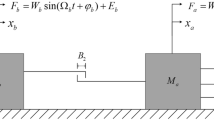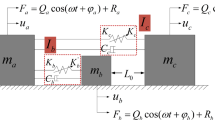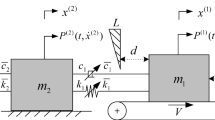Abstract
This paper deals with the discontinuous dynamic behaviors of a class of three-degree-of-freedom friction and collision system with symmetric bilateral rigid constraints by using the flow switching theory of discontinuous dynamical systems. The model takes into account the inequality of static and dynamic friction forces, which is more common in practice. The external excitation of the object contains a negative feedback, which can change with the variation of the velocity of the object, so that the system can adapt to different external environment. And the connection between the objects adopts nonlinear springs and viscous dampers in order to achieve a better vibration reduction effect. The model can be applied to mechanical equipment such as shock absorbers etc. According to the discontinuity caused by friction and collision, the dynamic domain and boundary of the object’s motion are defined in phase space, which requires the introduction of absolute coordinates and relative coordinates respectively to discuss the motion between objects. The vector field for the respective domain in the system is given, which can control the motion of object in each domain. The corresponding normal vector on the discontinuous boundary is introduced to determine the positive direction of the flow. The sufficient and necessary conditions for the switching motion of such dynamical system are given based on \(\mathrm{G}\)-function and its higher order. These switching conditions can be used to predict or even control the motion of the object on the separation boundary. In addition, several typical motions, such as sliding, stick, grazing, impact motions and periodic motion, are numerically simulated to better explain the complexity of the switching motion in the discontinuous dynamic system. Finally, the stick bifurcation scenarios for excitation frequency or amplitude are presented. The research results obtained can provide a theoretical basis for better use or control of friction and collision in practical applications.









Similar content being viewed by others
Data availability
All data generated or analyzed during this study are included in this article.
References
Filippov, A.F.: Differential equations with discontinuous right-hand side. Am. Math. Soc. Transl. 2(42), 99–231 (1964)
Filippov, A.F.: Differential Equations with Discontinuous Righthand Sides. Kluwer Academic Publishers, Dordrecht (1988)
Capone, G., D’Agostino, V., Valle, S.D., Guida, D.: Influence of the variation between static and kinetic friction on stick-slip instability. Wear 161, 121–126 (1993)
Galvanetto, U.: Some discontinuous bifurcations in a two-block stick-slip system. J. Sound Vib. 248(4), 653–669 (2001)
Andreaus, U., Casini, P.: Dynamics of friction oscillators excited by a moving base and/or drving force. J. Sound Vib. 245(4), 685–699 (2001)
Luo, A., Gegg, B.: An analytical prediction of sliding motions along discontinuous boundary in non-smooth dynamical systems. Nonlinear Dyn. 49, 401–424 (2007)
Olejnik, P., Awrejcewicz, J.: Application of Hénon method in numerical estimation of the stick-slip transitions existing in Filippov-type discontinuous dynamical systems with dry friction. Nonlinear Dyn. 73, 723–736 (2013)
Olejnik, P., Awrejcewicz, J., Fečkan, M.: An approximation method for the numerical solution of planar discontinuous dynamical systems with stick-slip friction. Appl. Math. Sci. 8(145), 7213–7238 (2014)
Liu, P., Yu, H., Cang, S.: On the dynamics of a vibro-driven capsule system. Arch. Appl. Mech. 88, 2199–2219 (2018)
Awrejcewicz, J., Olejnik, P.: Analysis of dynamic systems with various friction laws. ASME Appl. Mech. Rev 58(6), 389–411 (2005)
Shaw, S.W.: The dynamics of a harmonically excited system having rigid amplitude constraints, part 1: subharmonic motions and local bifurcations. J. Appl. Mech. 52(2), 453–458 (1985)
Shaw, S.W.: The dynamics of a harmonically excited system having rigid amplitude constraints, part 2: subharmonic motions and local bifurcations. J. Appl. Mech. 52(2), 459–464 (1985)
Nguten, D.T., Noah, S.T., Kettleborough, C.F.: Impact behaviour of an oscillator with limiting stops, part I: a parametric study. J. Sound Vib. 109(2), 293–307 (1986)
Tung, C.P.: The Dynamics of a nonharmonically excited system having rigid amplitude constraints. J. Appl. Mech. 59(3), 693–695 (1992)
Wiercigroch, M., Sin, V.W.T., Li, K.: Measurement of chaotic vibration in a symmetrically piecewise linear oscillator. Chaos, Solitons Fractals 9, 209–220 (1998)
Pust, L., Peterka, F.: Impact oscillator with Hertz’s model of contact. Meccanica 38(1), 99–116 (2003)
Gendelman, O.V.: Modeling of inelastic impacts with the help of smooth-functions. Chaos, Solitons Fractals 28, 522–526 (2006)
Luo, G., Xie, J., Zhu, X., Zhang, J.: Periodic motions and bifurcations of a vibro-impact system. Chaos, Solitons Fractals 36, 1340–1347 (2008)
Zhao, X.: Discontinuity Mapping for Near-Grazing Dynamics in Vibro-Impact Oscillators, pp. 275–285. Springer, Berlin (2009)
Aguiar, R.R., Weber, H.I.: Mathematical modeling and experimental investigation of an embedded vibro-impact system. Nonlinear Dyn. 65, 317–334 (2011)
Chu, S., Cao, D., Sun, S., Pan, J., Wang, L.: Impact vibration characteristics of a shrouded blade with asymmetric gaps under wake flow excitations. Nonlinear Dyn. 72, 539–554 (2013)
Czolczynski, K., Blazejczyk-Okolewska, B., Okolewski, A.: Analytical and numerical investigations of stable periodic solutions of the impacting oscillator with a moving base. Int. J. Mech. Sci. 115–116, 325–338 (2016)
Hedrih, K.R.S.: Nonlinear phenomena in vibro-impact dynamics: central collisions and energy jumps between two rolling bodies. Nonlinear Dyn. 91, 1885–1907 (2018)
Kumar, P., Narayanan, S.: Chaos and bifurcation analysis of stochastically excited discontinuous nonlinear oscillators. Nonlinear Dyn. 102, 927–950 (2020)
Luo, G., Zhang, Y.: Analyses of impact motions of harmonically excited systems having rigid amplitude constraints. Int. J. Impact Eng 34, 1883–1905 (2007)
Luo, G., Zhang, Y., Xie, J., Zhang, J.: Vibro-impact dynamics near a strong resonance point. Acta. Mech. Sin. 23, 329–341 (2007)
Manevitch, L.I.: Vibro-Impact Models for Smooth Non-linear Systems, pp. 191–201. Springer, Berlin (2009)
Fu, X., Zheng, S.: New approach in dynamics of regenerative chatter research of turning. Commun. Nonlinear Sci. Numer. Simulat. 19, 4013–4023 (2014)
Luo, G.W., Shi, Y.Q., Jiang, C.X., Zhao, L.Y.: Diversity evolution and parameter matching of periodic-impact motions of a periodically forced system with a clearance. Nonlinear Dyn. 78, 2577–2604 (2014)
Moreau, J.: Unilateral contact and dry friction in finite freedom dynamics. Nonsmooth Mech. Appli. 302, 1–82 (1988)
Cone, K.M., Zadoks, R.I.: A numerical study of an impact oscillator with the addition of dry friction. J. Sound Vib. 188(5), 659–683 (1995)
Hinrichs, N., Oestreich, M., Popp, K.: Dynamics of oscillators with impact and friction. Chaos, Solitons Fractals 8(4), 535–558 (1997)
Yigit, A.S., Christoforou, A.P.: Coupled torsional and bending vibrations of drillstrings subject to impact with friction. J. Sound Vib. 215(1), 167–181 (1998)
Virgin, L.N., Begley, C.J.: Grazing bifurcations and basins of attraction in an impact-friction oscillator. Physica D 130, 43–57 (1999)
Virgin, L.N., Begley, C.J.: Nonlinear features in the dynamics of an impact-friction oscillator. AIP Conf. Proc. 502, 469–475 (2000)
Krivtsov, A.M., Wiercigroch, M.: Dry friction model of percussive drilling. Meccanica 34(6), 425–434 (1999)
Lankarani, H.M., Pereira, M.: Treatment of impact with friction in planar multibody mechanical systems. Multibody Syst. Dyn. 6, 203–227 (2001)
Andreaus, U., Casini, P.: Friction oscillator excited by moving base and colliding with a rigid or deformable obstacle. Int. J. Non-linear Mech. 37, 117–133 (2002)
Pavlovskaia, E., Wiercigroch, M., Woo, K.C., Rodger, A.A.: Modelling of ground moling dynamics by an impact oscillator with a frictional slider. Meccanica 38(1), 85–97 (2003)
Marghitu, D.B., Stoenescu, E.D.: Rigid body impact with moment of rolling friction. Nonlinear Dyn. 50, 597–608 (2007)
Dankowicz, H., Svahn, F.: Control of instabilities induced by low-velocity collisions in a vibro-impacting system with friction, pp. 41–52. Springer, Berlin (2009)
Nordmarka, A., Dankowiczb, H., Champneys, A.: Discontinuity-induced bifurcations in systems with impacts and friction: discontinuities in the impact law. Int. J. Non-linear Mech. 44, 1011–1023 (2009)
Ho, J.H., Nguyen, V.D., Woo, K.C.: Nonlinear dynamics of a new electro-vibro-impact system. Nonlinear Dyn. 63, 35–49 (2011)
Ghaednia, H., Marghitu, D.B.: Permanent deformation during the oblique impact with friction. Arch. Appl. Mech. 86, 121–134 (2016)
Pascal, M.: A new model of dry friction oscillator colliding with a rigid obstacle. Nonlinear Dyn. 91(1), 1–10 (2018)
Luo, A., Guo, C.: A period-1 motion to chaos in a periodically forced, damped, double-pendulum. J. Vib. Test. Syst. Dyn. 3(3), 259–280 (2019)
Xing, S., Luo, A.: On period-1 motions to chaos in a 1-dimensional, time-delay, nonlinear system. Int. J. Dyn. Control 8, 44–50 (2020)
Chatterjee, A., Bowling, A.: Modeling three-dimensional surface-to-surface rigid contact and impact. Multibody Syst. Dyn. 46, 1–40 (2019)
Li, X., Shen, J., Akca, H., Rakkiyappan, R.: LMI-based stability for singularly perturbed nonlinear impulsive differential systems with delays of small parameter. Appl. Math. Comput. 250, 798–804 (2015)
Li, X., Shen, J., Rakkiyappan, R.: Persistent impulsive effects on stability of functional differential equations with finite or infinite delay. Appl. Math. Comput. 329, 14–22 (2018)
Liu, Y., Zhang, Y., Li, H., Alsaadi, F., Ahmad, B.: Control design for output tracking of delayed Boolean control networks. J. Comput. Appl. Math. 327, 188–195 (2018)
Xu, X., Li, H., Li, Y., Alsaadi, F.: Output tracking control of Boolean control networks with implusive effects. Math. Method Appl. Sci. 41(4), 1554–1564 (2018)
Li, H., Xu, X., Ding, X.: Finite-time stability analysis of stochastic switched Boolean networks with impulsive effect. Appl. Math. Comput. 347, 557–565 (2019)
Fan, J., Li, L.: Existence of positive solutions for P-Laplacian dynamic equations with derivative on time scales. J. Appl. Math. 7 (2013)
Wagg, D.: Multiple non-smooth events in multi-degree-of-freedom vibro-impact systems. Nonlinear Dyn. 43, 137–148 (2006)
Zhao, Z., Liu, C., Chen, B.: The numerical method for three-dimensional impact with friction of multi-rigid-body system. Sci. China Ser. G 49(1), 102–118 (2006)
Zhao, Z., Liu, C.: The analysis and simulation for three-dimensional impact with friction. Multibody Syst. Dyn. 18, 511–530 (2007)
Pfeiffer, F.: On Impacts with Friction in Engineering Systems, pp. 217–230. Springer, Berlin (2009)
Awrejcewicz, J., Kudra, G.: Bifurcation and chaos of multi-body dynamical systems. Springer Proceedings in Physics 139 (2011)
Flores, P., Leine, R., Glocker, C.: Application of the nonsmooth dynamics approach to model and analysis of the contact-impact events in cam-follower systems. Nonlinear Dyn. 69, 2117–2133 (2012)
Fadaee, M., Yu, S.: Vibrational behavior of MDOF oscillators subjected to multiple contact constraints. J. Mech. Sci. Technol. 31(4), 1551–1560 (2017)
Marques, F., Flores, P., Claro, J.C.P., Lankarani, H.M.: Modeling and analysis of friction including rolling effects in multibody dynamics: a review. Multibody Syst. Dyn. 45(2), 223–244 (2019)
Xu, H., Ji, J.: Creation of Neimark-Sacker bifurcation for a three-degree-of-freedom vibro-impact system with clearances. Nonlinear Dyn. Struct. Syst. Devices 1, 107–115 (2020)
Luo, A.: A theory for non-smooth dynamic systems on the connectable domains. Commun. Nonlinear Sci. Numer. Simul. 10, 1–55 (2005)
Luo, A.: Flow switching bifurcations on the separation boundary in discontinuous dynamical systems with flow barriers. Proc. IMechE Part K J. Multi-Body Dyn. 221, 475–485 (2007)
Luo, A.: On flow switching bifurcations in discontinuous dynamical systems. Commun. Nonlinear Sci. Numer. Simul. 12, 100–116 (2007)
Luo, A.: A theory for flow switchability in discontinuous dynamical systems. Nonlinear Anal. Hybrid Syst 2, 1030–1061 (2008)
Luo, A., Zwiegart, P.: Existence and analytical predictions of periodic motions in a periodically forced, nonlinear friction oscillator. J. Sound Vib. 309(1–2), 129–149 (2008)
Luo, A.: Discontinuous Dynamical Systems. Higher Education Press, Beijing (2010)
Fan, J., Yang, Z.: Analysis of dynamical behaviors of a 2-DOF vibro-impact system with dry friction. Chaos, Solitons Fractals 116, 176–201 (2018)
Li, C., Fan, J., Yang, Z., Xue, S.: On discontinuous dynamical behaviors of a 2-DOF impact oscillator with friction and a periodically forced excitation. Mech. Mach. Theory 135, 81–108 (2019)
Huang, J., Fu, X.: Stability and chaos for an adjustable excited oscillator with system switch. Commun. Nonlinear Sci. Numer. Simul. 77, 108–125 (2019)
Gao, M., Fan, J.: Analysis of dynamical behaviors of a 2-DOF friction oscillator with elastic impacts and negative feedbacks. Nonlinear Dyn. 102, 45–78 (2020)
Huang, J., Fu, X., Jing, Z.: Singular dynamics for morphing aircraft switching on the velocity boundary. Commun. Nonlinear Sci. Numer. Simul. 95,(2021)
Acknowledgements
This research was supported by the National Natural Science Foundation of China (No. 11971275) and the Natural Science Foundation of Shandong Province, China (No. ZR2019MA048). The authors would like to thank the Associate Editor and the anonymous reviewers for their constructive comments and suggestions which improved the quality of this paper a lot.
Author information
Authors and Affiliations
Corresponding author
Ethics declarations
Conflict of interest
The authors declare that they have no competing interests.
Additional information
Publisher's Note
Springer Nature remains neutral with regard to jurisdictional claims in published maps and institutional affiliations.
Appendices
Appendix A
Without appearance of stick, the different domains of the masses \(m_1\) and \(m_2\) are defined as
and the corresponding boundaries are denoted by
where \(i\ne \overline{i}\in \{1,2\},\,\xi \in \{1,2\}\,\,\mathrm and\,\,\theta \in \{0,1\}\).
The vertex of boundaries are defined as
where \(\xi \in \{1,2\}\,\,\mathrm{and}\,\,\theta \in \{0,1\}\).
The above domains and boundaries are shown in Fig. 10a, b. The domains \(\Omega _1^{(1)}\) and \(\Omega _2^{(1)}\) represent the domains where the mass \(m _{1}\) does free-flight motion without stick and are expressed in gray and purple, respectively. The domains \(\Omega _{\xi ^0}^{(2)}\) and \(\Omega _{\xi ^1}^{(2)}\) \((\xi =1,2)\) represent the domains where the mass \(m _{2}\) does free-flight motion without stick and are expressed in different shades of gray and purple, respectively. The velocity boundaries \(\partial \Omega _{12}^{(1)}\), \(\partial \Omega _{{1^0}{2^0}}^{(2)}\) and \(\partial \Omega _{{1^1}{2^1}}^{(2)}\) are expressed in red dashed lines and the impact-chatter boundaries \( {}^+\!\partial \Omega _{\tau \infty }^{(i)}\) and \( {}^-\!\partial \Omega _{\tau \infty }^{(i)}\) \( (i=1,2 ,\tau =1,2)\) are expressed in black dashed curves. Furthermore, the stuck boundaries \(\partial \Omega _{{1^0}{1^1}}^{(2)}\) and \(\partial \Omega _{{2^0}{2^1}}^{(2)}\) for the mass \(m _{2}\) are expressed in orange dashed lines.
With appearance of stick, the different domains of the masses \(m_1\) and \(m_2\) are defined as
and the corresponding boundaries are denoted by
where \(i\ne \overline{i}\in \{1,2\},\,\, \xi ,\tau \in \{1,2\}\,\,\mathrm and\,\,\theta \in \{0,1\}\). The above domains and boundaries are shown in Fig. 11a, b. The domains \(\Omega _3^{(1)}\) and \(\Omega _4^{(1)}\) represent the domains where the mass \(m _{1}\) does stick motion, which are expressed in green and blue, respectively. The domains \(\Omega _{\xi ^0}^{(2)}\) and \(\Omega _{\xi ^1}^{(2)}\) \((\xi =3,4)\) represent the domains where the mass \(m _{2}\) does stick motion, which are expressed in different shades of green and blue, respectively. The stick boundaries \(\partial \Omega _{\tau 3}^{(i)}\) and \( \partial \Omega _{\tau 4}^{(i)} \) are expressed in black dotted lines. And the stuck boundaries \(\partial \Omega _{{3^0}{3^1}}^{(2)}\) and \( \partial \Omega _{{4^0}{4^1}}^{(2)} \) for the mass \(m _{2}\) are expressed in green and blue dashed lines.
For the free motion of the mass \(m _{3}\), the absolute domains \(\Omega _1^{(3)}\) and \(\Omega _2^{(3)}\) and stuck boundary \( \partial \Omega _{12}^{(3)}\) are defined as
Herein, the phase plane is partitioned into two domains by a boundary, which are sketched in Fig. 12. The domains \(\Omega _1^{(3)}\) and \(\Omega _2^{(3)}\) represent the domains of free motion for the mass \(m_{3}\), which are represented by the light gray and light purple areas, respectively. The boundary \(\partial \Omega _{12}^{(3)}\) is the velocity boundary, and it is depicted by the orange dashed line.
Appendix B
The relative domains for the motions of the masses \(m_i\;(i=1,2)\) are defined as
and the corresponding boundaries are denoted by
where \(i\ne \overline{i}\in \{1,2\},\,\xi \in \{1,2\},\,\theta \in \{0,1\}\,\,\mathrm{and}\,\,\tau =1,2\). The relative domains and boundaries are shown in Fig. 13a, b. The stick domains and stick boundaries in relative coordinates become the blue points.
Rights and permissions
About this article
Cite this article
Gao, M., Fan, J. Discontinuous dynamics for a class of 3-DOF friction and collision system with symmetric bilateral rigid constraints. Nonlinear Dyn 106, 1739–1768 (2021). https://doi.org/10.1007/s11071-021-06924-z
Received:
Accepted:
Published:
Issue Date:
DOI: https://doi.org/10.1007/s11071-021-06924-z








